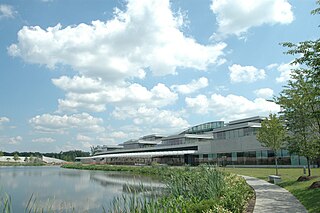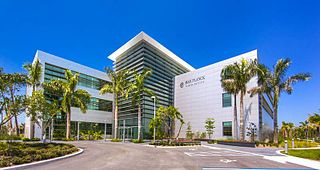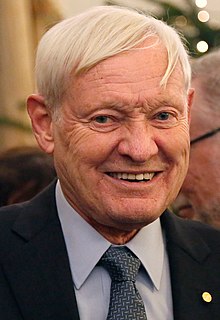Related Research Articles

Carlos José Bustamante is a Peruvian-American scientist. He is a member of the National Academy of Sciences.

Pamela Jane Bjorkman NAS, AAAS is an American biochemist. She is the David Baltimore Professor of Biology and Biological Engineering at the California Institute of Technology (Caltech), Her research centers on the study of the three-dimensional structures of proteins related to Class I MHC, or Major Histocompatibility Complex, proteins of the immune system and proteins involved in the immune responses to viruses. Bjorkman is most well known as a pioneer in the field of structural biology.
The Presidential Early Career Award for Scientists and Engineers (PECASE) is the highest honor bestowed by the United States government on outstanding scientists and engineers in the early stages of their independent research careers. The White House, following recommendations from participating agencies, confers the awards annually. To be eligible for a Presidential Award, an individual must be a US citizen, national or permanent resident. Some of the winning scientists and engineers receive up to a five-year research grant.
Charles Howard Vollum was an American electronics engineer, businessman, and philanthropist in Oregon, United States. He was the co-founder of Tektronix Corporation, and endowed the Vollum Institute.

Richard Henderson is a Scottish molecular biologist and biophysicist and pioneer in the field of electron microscopy of biological molecules. Henderson shared the Nobel Prize in Chemistry in 2017 with Jacques Dubochet and Joachim Frank.

Eva Nogales is a biophysicist at the Lawrence Berkeley National Laboratory and a Professor at the University of California, Berkeley, where she served head of the Division of Biochemistry, Biophysics and Structural Biology of the Department of Molecular and Cell Biology (2015-2020). She is a Howard Hughes Medical Institute investigator.

Janelia Research Campus is a scientific research campus of the Howard Hughes Medical Institute that opened in October 2006. The campus is located in Loudoun County, Virginia, near the town of Ashburn. It is known for its scientific research and modern architecture. The current Executive Director of the laboratory is Ronald Vale, who is also a vice-president of HHMI. He succeeded Gerald M. Rubin in 2020. The campus was known as "Janelia Farm Research Campus" until 2014.
The Searle Scholars Program is a career development award made annually to the 15 young US professionals in biomedical research and chemistry considered most promising. The award was established in 1980 by a donation from the Searle family, and is operated by the Chicago Community Trust.

The Life Sciences Institute (LSI) is a collaborative, multidisciplinary research institution located on the campus of the University of Michigan in Ann Arbor. It encompasses 26 faculty-led teams from 12 schools and departments throughout U-M. The LSI brings together leading scientists from a variety of life science disciplines, working with a range of models systems and cutting-edge research tools, to accelerate breakthroughs and discoveries that will broaden understanding of the basic processes of life and lead to new treatments to improve human health.
The Ernst Ruska-Centre for Microscopy and Spectroscopy with Electrons (ER-C) is an institute located on the campus of Forschungszentrum Jülich belonging to the Helmholtz Association of German Research Centres. It comprises three divisions: ER-C-1 “Physics of Nanoscale systems”, ER-C-2 “Materials Science and Technology” and ER-C-3 “Structural Biology”.

The Max Planck Florida Institute for Neuroscience (MPFI), is a research facility located in Jupiter, Florida. Its research focuses on brain function and neural circuits, using techniques to visualize microscopic molecular processes. It is the first institute established by the Max Planck Society in North America.

Henning Stahlberg is a German physicist and Professor at the Swiss Federal Institute of Technology Lausanne and the University of Lausanne, Switzerland.

Robert Eric Betzig is an American physicist who works as a professor of physics and professor of molecular and cell biology at the University of California, Berkeley. He is also a senior fellow at the Janelia Farm Research Campus in Ashburn, Virginia.
The Vollum Institute is an independent research institute located in Marquam Hill Campus of the Oregon Health and Science University (OHSU) in southwest Portland, Oregon, USA. The institute is closely affiliated with the School of Medicine and many other the universities nearby.

Joachim Frank is a German-American biophysicist at Columbia University and a Nobel laureate. He is regarded as the founder of single-particle cryo-electron microscopy (cryo-EM), for which he shared the Nobel Prize in Chemistry in 2017 with Jacques Dubochet and Richard Henderson. He also made significant contributions to structure and function of the ribosome from bacteria and eukaryotes.

Jacques Dubochet is a retired Swiss biophysicist. He is a former researcher at the European Molecular Biology Laboratory in Heidelberg, Germany, and an honorary professor of biophysics at the University of Lausanne in Switzerland.

Cryogenic electron microscopy (cryo-EM) is a cryomicroscopy technique applied on samples cooled to cryogenic temperatures. For biological specimens, the structure is preserved by embedding in an environment of vitreous ice. An aqueous sample solution is applied to a grid-mesh and plunge-frozen in liquid ethane or a mixture of liquid ethane and propane. While development of the technique began in the 1970s, recent advances in detector technology and software algorithms have allowed for the determination of biomolecular structures at near-atomic resolution. This has attracted wide attention to the approach as an alternative to X-ray crystallography or NMR spectroscopy for macromolecular structure determination without the need for crystallization.

Tamir Gonen is an American structural biochemist and membrane biophysicist best known for his contributions to structural biology of membrane proteins, membrane biochemistry and electron cryo-microscopy (cryoEM) particularly in electron crystallography of 2D crystals and for the development of 3D electron crystallography from microscopic crystals known as MicroED. Gonen is an Investigator of the Howard Hughes Medical Institute, a professor at the University of California, Los Angeles, the founding director of the MicroED Imaging Center at UCLA and a Member of the Royal Society of New Zealand.

Ping Zhang is an American structural biologist researching the structural and mechanistic basis of multi-component kinase signaling complexes that are linked to human cancers and other diseases, with a long-term goal of developing new therapeutic strategies. She is a NIH Stadtman Investigator in the Structural Biophysics Laboratory at the National Cancer Institute.
Elizabeth Villa is an American biophysicist who is Associate Professor at the University of California, San Diego. Her research considers the development of Cryo Electron Tomography and structural biology. She was named a Howard Hughes Medical Institute Research Investigator in 2021.
References
- 1 2 3 4 "Eric Gouaux". Oregon Health & Science University. Retrieved 13 January 2019.
- ↑ "J. Eric Gouaux". Searle Scholars Program. Retrieved 13 January 2019.
- ↑ "Eric Gouaux". Howard Hughes Medical Institute. Retrieved 13 January 2019.
- ↑ "James Eric Gouaux". National Academy of Sciences. Retrieved 13 January 2019.
- ↑ "Gouaux Lab". Vollum Institute. Retrieved 13 January 2019.
- ↑ Pool, Rebecca. "National cryo-EM centres to open across the US". Microscopy and Analysis. Retrieved 13 January 2019.
- ↑ "PNNL part of a new national center for near-atomic resolution of biological molecules". Pacific Northwest National Laboratory. Retrieved 13 January 2019.